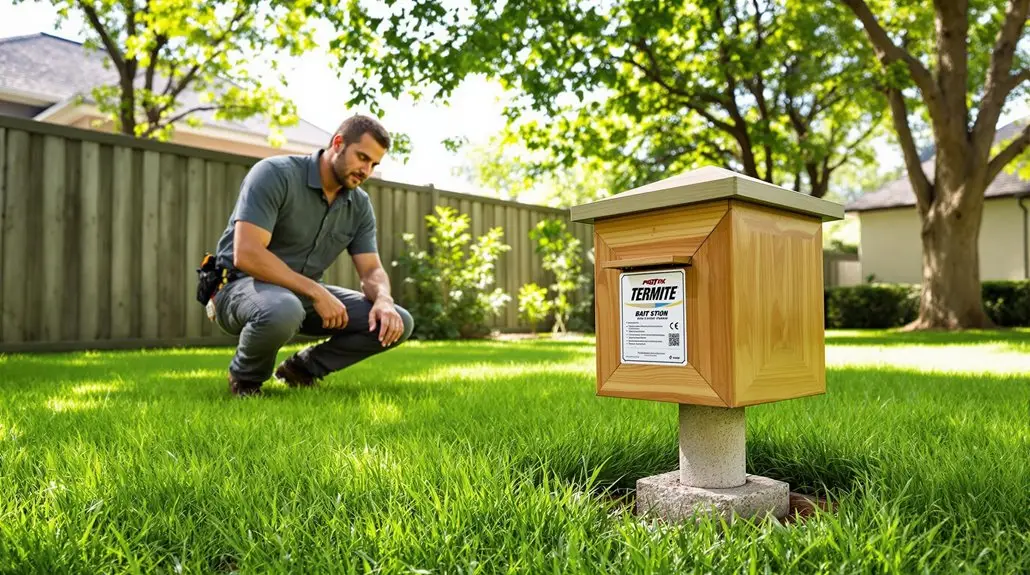Many homeowners wonder whether termite bait stations truly offer a reliable solution for pest control. While these systems provide several environmental and protection benefits, including reduced risks to children and pets, there are also significant considerations to address. Understanding their mechanism of action, installation requirements, and long-term costs will help you decide if they are suitable for your property. However, the question remains: are the advantages worth the potential downsides?
Key Insights
- Pros: Eco-friendly pest management minimizes soil contamination and preserves beneficial insects, promoting overall biodiversity.
- Cons: Initial setup costs for bait stations can range from $1,500 to $3,000, which may be higher than some chemical treatments.
- Pros: Slow-acting insecticides in bait stations effectively target active termite colonies while reducing environmental impact through minimal chemical use.
- Cons: Monitoring and maintenance require regular inspections every three months, adding to long-term commitment and potential costs.
- Pros: Bait stations can prevent costly termite damage repairs, which can exceed $5,000, making them a financially sound investment over time.
Environmental and Safety Benefits
While many pest control methods can pose risks to both the environment and human health, termite bait stations offer significant environmental and protective benefits that make them an increasingly popular choice among homeowners. These systems minimize soil contamination by reducing chemical leaching into groundwater, thereby protecting essential ecosystems. They also preserve beneficial insects, like ladybugs and mantises, through their targeted application. Additionally, termite bait stations improve air quality by eliminating volatile organic compounds commonly found in traditional pest control methods. With their contained bait, these stations pose lower risks of accidental ingestion for pets and children, ensuring a more secure home environment. By promoting biodiversity and utilizing eco-friendly materials, termite bait stations align with sustainable pest management practices. Furthermore, sustainable pest control practices are crucial for urban ecosystem health, highlighting the importance of adopting such methods in densely populated areas. This method adheres to the principles of Integrated Pest Management (IPM), which focuses on prevention and monitoring for effective pest management.
Mechanism of Action and Effectiveness
Understanding the mechanism of action and effectiveness of termite bait stations is essential for homeowners seeking reliable pest control solutions. These stations utilize slow-acting insecticides that disrupt termite molting, ultimately leading to colony death. Chitin synthesis inhibitors, like diflubenzuron, prevent the production of chitin necessary for growth, causing termites to die as they attempt to molt. Bait stations target active colonies, minimizing environmental impact by using insecticides only when necessary. Termites inadvertently consume the bait while foraging and share the insecticide within the colony, enhancing control. However, the success of bait stations hinges on their placement near active colonies and regular monitoring, as inactivity or alternative food sources can delay effectiveness and limit results. Recent research indicates that seasonal effects such as moisture and temperature significantly influence termite foraging behavior, impacting bait discovery and consumption rates.
Installation and Property Suitability

When installing termite bait stations, it’s essential to position them effectively around your property to maximize their impact on active termite colonies. Ideally, place the stations 1-2 feet from your foundation, avoiding previously treated soil. You should space the stations no more than 20 feet apart, with 10-20 feet being common for accessibility. Dig holes to accommodate the stations, ensuring they sit flush with the soil surface. If working with concrete or asphalt, drilling is necessary, and the hole should be filled with soil to maintain a continuous soil zone. Choose moist or potentially moist soil for peak performance, as termites thrive in such conditions. Proper soil compaction during installation ensures that the stations remain stable and effective over time. These stations are suitable for both residential and commercial properties, particularly in environmentally sensitive areas.
Cost Considerations and Financial Impact
Cost considerations play an essential role in deciding whether to implement termite bait stations as a pest control solution, given that the initial investment can range from $1,500 to $3,000 for most homes. While chemical treatments can cost between $3 and $20 per linear foot, bait stations typically range from $7 to $12 per linear foot, presenting a potentially more cost-effective option. Although tented fumigation and heat treatments can reach $8,000, bait stations may help prevent such significant damage. Additionally, annual monitoring costs between $200 and $400, which can be overshadowed by the potential expenses of termite damage repairs, sometimes exceeding $5,000. Consequently, investing in bait stations can yield long-term financial benefits by minimizing future repairs. Moreover, the initial setup costs for bait stations are often lower than those for liquid treatments, making them an attractive choice for homeowners.
Monitoring and Maintenance Requirements
Effective monitoring and maintenance of termite bait stations are essential components in guaranteeing their success as a pest control solution, as regular inspections and timely interventions can greatly enhance their effectiveness. You’ll need to conduct inspections every three months and replace inspection cartridges with bait cartridges upon detecting termite activity. Additionally, bait cartridges require checks every 60 days until activity ceases. It’s crucial to remember that the active ingredient in the bait cartridges can take approximately 60 days for colony elimination.
| Task | Frequency |
|---|---|
| Station Inspection | Every 3 months |
| Bait Cartridge Check | Every 60 days |
| Replacement of Components | As needed |
| Monitoring Reports | Ongoing |
Moreover, maintaining the stations involves checking for water damage and replacing moldy components to assure ideal function.
Final Thoughts
Conclusion: The Balancing Act of Termite Bait Stations
In summary, while termite bait stations may appear to be an eco-friendly and cost-effective solution for termite control, their effectiveness often requires a patient approach, which can feel ironic when immediate results are the expectation. You’ll benefit from their environmental and security advantages, yet the need for ongoing monitoring and maintenance might just turn your initial enthusiasm into a labor-intensive endeavor. Ultimately, weighing these factors will help you determine if this method aligns with your pest control needs and lifestyle.
Ready to Take Action Against Termites?
For residents in South Florida, consider partnering with NaturePest Holistic Pest Control for a comprehensive evaluation of your pest management options. Our experts are here to guide you through the process and ensure your home remains safe and pest-free!


